The col de la Core is not a famous climb – in cycling, or any other sport. There are no champions’ names spray painted on the ground, no monuments at the top to riders past or present. It has no especially beautiful scenery or harsh gradients. It is a simple, two-lane road, and on a Saturday morning last month, it nearly killed me.
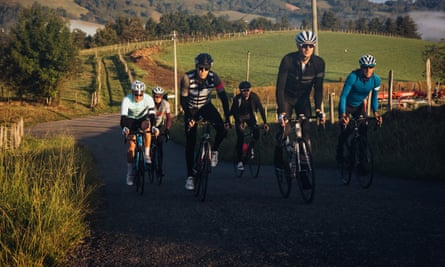
The Cent Cols Challenge is sometimes described as the hardest amateur cycling event in Europe. It is a 10-day, 10-stage journey, in one of a handful of the continent’s mountain ranges; the Alps, the Dolomites, or - in September this year - the Pyrenees. The task is brutal in its simplicity: climb 100 mountain passes (cols). The reality is overwhelming.
On an any given day a rider must spend 12 hours on their bike, eat and burn more than 8,000 calories, and ride more than 200km in conditions from dark and wet to scorching heat, and sometimes over farm tracks. They must ignore saddle sores, knee and neck pain, back pain, wrist and foot pain, freeze and dehydrate, ride until their chain breaks or their tyres deflate, until their eyes are bloodshot and they are numb. Then they eat, wash and go to bed – with the knowledge it all starts again in a few short hours, on repeat for 10 days.
It is not surprising that of the 30 or so riders who attempt the challenge, less than a third complete every kilometre of the route.
The challenge, now in its eighth year, was created by Phil Deeker, a former fireworks technician. The 59-year-old started riding for the second time (like so many others he rode in his youth and rediscovered the sport years later) in 1998, on his daily commute. Nine years later, he set himself a daunting challenge: to ride through the Alps, and across the Pyrenees, summiting 300 mountain passes in just 26 days. He finished in July 2007 and the challenge was born.
By autumn this year Deeker had shepherded close to 500 riders through thousands of kilometres in 24 editions of the journey. Last month, I was one of the latest batch.
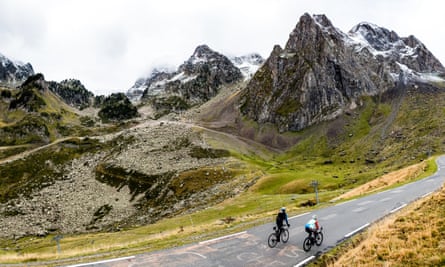
“Forget where you have come from, or where you are going,” the challenge’s briefing starts. “What counts is the here and now. It will be tougher for some riders than others, your mind will almost certainly play games with you, and there will be days when the cycling gods choose to keep some of the mountains for themselves.”
The numbers are staggering. The Pyrenees edition – one of the first routes devised by Deeker almost 10 years ago – is more than 2,000km long and climbs just over 50,000 metres. Its longest stage, from St-Lary-Soulan to Oloron, is 226km, tackles 6,000m of uphill roads and comes after four days of punishing cycling. According to Strava, a social network for athletes, in 10 days I logged 97hr and 24min pedalling.

To mask the true scale of the challenge, Deeker suggests breaking it down as follows: the trip goes in two halves, the halves break down into days, and the days into four chunks. Those quarters are: a 7.30am start and 50km to feed one, the same distance to lunch, the same again to feed three and one more 50km drag to that night’s hotel, dinner and bed. The first quarter of the day was almost always cold and wet, and as the event progressed, legs took longer to flush out the lactic acid and heart rates refused to rise.
But ask riders about the daily routine and you’ll get a different answer every time – each one subtly shifting the timeline to emphasise the section that offered them the most compelling reasons to quit. But it will almost always involve food.
With legs still swollen from the previous days’ efforts and the lingering remnants of a dehydration headache, the mornings were especially hard. They felt like enduring a bad hangover, and, just like the recently inebriated, we would struggle with the idea of hauling our protesting bodies out of bed, pouring them into kit still damp from the previous night’s hotel-sink wash and filling them with more muesli than seems plausible. To then force them to scale an endless succession of French mountains was – from stage three onwards – enough to make anyone swap our metaphorical hangovers for a real one. What difference, we would joke, could it possibly make?

During the event, Jered Gruber, a former professional cyclist who has become one half of the renowned photography team Gruber Images, made a habit of pointing out at lunchtime that the morning’s endeavours amounted to a substantial achievement in their own right, and repeating them in the afternoon seemed a little unnecessary. “That was a big ride,” he’d say. “On any other day, I’d be happy with that.” The prospect of repeating that feat immediately, riding through the afternoon and well into the evening was a daily torment.
But there is one character trait that unites every rider who attempts the challenge: they are comfortable with discomfort. “You needs to know what climbing for two hours non-stop means. It’s about that ability to endure,” Deeker says. But if that familiarity with pain is universal, then so to is an appreciation that there is something rejuvenating, even restful, in that pain.
Jennifer Burtner works as an A&E doctor in a Seattle hospital that is often as short-staffed and underfunded as those of the NHS. Despite holding down such a demanding job, her holidays for the last six years have involved flying halfway around the world to ride her bike to the point of exhaustion.
Riding with her husband, Tim, she often finished well after dark, by which time the stronger riders had showered, rested and, at least once, were already starting the evening meal. But determined to ride every inch of the route, and despite having less time to recover than many others, she would wake up earlier and set off the next day, riding by torchlight to get a jump start on the climbs.

“No trip has come close to what you do on the Cent Cols,” Tim says. “By day three, you have pretty much ridden what you might ride in any typical bike trip. But it is the kind of riding, and the people that are riding with you, that make it so special. Everyone is taking on something much bigger than themselves.”
That refusal to quit is infectious, and the few riders who did stop before the end did so after serious injury or mechanical failure. Howard Dyson became the first casualty after hitting a patch of gravel on a tight bend leaving Saillagouse. He collided so hard with a stone wall that it split his helmet. Jeff Wills, 47, one of the event’s strongest riders, crashed on stage seven. He too split his helmet, fracturing several vertebrae in his neck in the process. Having recovered from a broken collar bone three months earlier, he went back into surgery to have pins inserted in the breaks and spent five days immobile in a Lourdes hospital. “It was very upsetting to stop like that,” he recalls. “Until that point, stopping never crossed my mind.
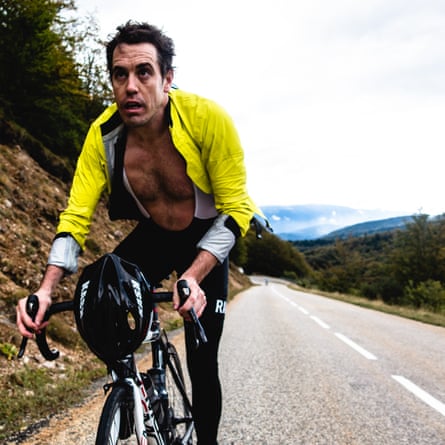
“Everyone shared this idea of ‘the challenge’: no one wanted to stop; no one was whining; no one was lazy. Every day the group was up for it. I like being with people like that. Although it could take a year for my injuries to heal, I have already signed up for 2017.”
Others arrived back in Perpignan battered and bruised, nursing swollen limbs and road rash (myself included). The fatigue, though, is universal. Every rider, weeks after the event had finished, spoke as if they had only just caught their breath. Some still mentioned recovery as some far-off destination that might be reached with a few more days and a few more espressos.
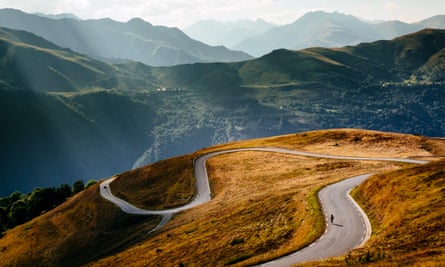
For all that turmoil, and more than a century after they debuted in the Tour de France, the Pyrenees still feel like an undiscovered playground. The mountains, which form a natural border between France and Spain, are mostly pastoral. In a full day’s riding, a group could pass more cattle than cars, and for most riders, who train in cities and on turbo trainers, it was a luxury so rare it made up for the hardship.
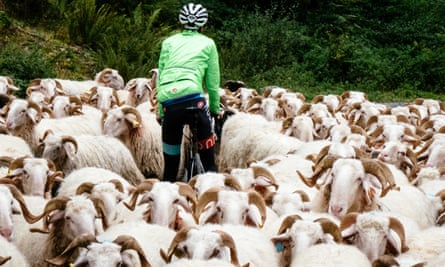
Mike Bluett, a trader in London, said the views of valleys conquered and peaks to come made stage five his best and worst day on the bike. “Riding up La Hourquette d’Ancizan, seeing the ragged mountain in front of me, a slight smattering of snow near the summit, that was the best moment,” he says. “But I was exhausted and hadn’t eaten enough. I was reduced to tears and felt overwhelmingly lucky to be on my bike and where I was.”
That determination bordering on stupidity, and respect for the sport and its setting, bears close resemblance to the great audax riders and racers of cycling history, and the Pyrenees is the perfect setting to see it thrive. According to Pierre Chany, a cycling correspondent at L’Equipe for 35 years, the area was included in the Tour de France on the insistence of another cyclist and writer, Alphonse Steinnes. Chany says Steinnes was the driving force behind the tour’s notoriously long stages and jagged profiles, and in 1907 he made an audacious bid to have the Tourmalet climb added to the race.
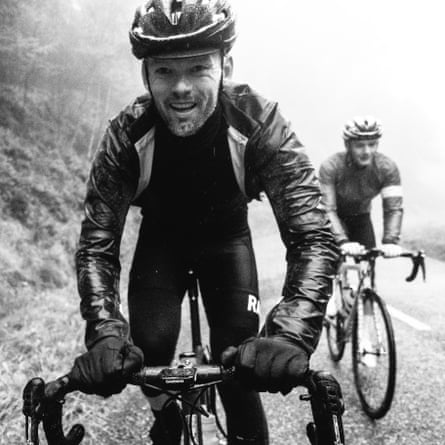
He took the race organisers to examine the 2,115m summit but 16km up the road, their driver could go no further and Steinnes was forced to start walking the remaining distance to the top. Freezing and alone, he became disorientated, fell twice as he stumbled up the icy path and was eventually found by a search and rescue team. After a hot bath, Steinnes dispatched a telegram: “Crossed Tourmalet. Very good. Perfectly feasible.”
At the base of the Col de la Core, that unremarkable stretch of Pyrenean road that nearly killed me, nothing felt perfectly feasible. Blue-lipped, teeth chattering and hands so cold it hurt to hold the bike, I punctured. We had descended for 20 minutes in ice-cold rain and joined a single-lane track – the kind with weeds, mud and stones down the centre. By the time Deeker caught up, I was sheltered under a tree, sopping wet – despite two waterproofs, a jacket and two jerseys – and shaking. I was on a back road through a valley in southern France that I might never visit again but will always remember as the place where I asked the most basic questions of myself and came back empty-handed. I was ready to quit.
Every rider who has completed a Cent Cols challenge has had a moment like this, one that made them ask whether they could possibly keep turning the pedals. But they have also had moments of complete freedom, unencumbered by the stresses of home or work and – if only fleetingly – convinced they can master whatever comes next.

For me, they came on the Hourquette D’Ancizan, climbing through cloud and fog on stage five to see for the first time, up close, the snow-capped peaks of the High Pyrenees. They came at the end of the same day, struggling up the Aubisque after 6,000m and knowing we’d reached halfway. And they came with the laughter on a particularly hard morning, having realised one rider was so tired they had ridden for 60km with their bib shorts inside out and not noticed. They came on the rest day, ordering more food for six people than could be eaten by 60. They came on stage eight – the back road stage – when the weather finally turned in our favour, and then again on stage nine as the sun set over the valley at the ancient thermal baths of Ax-Les-Thermes. They came as we remembered stage one, so long ago, when we were new and fresh and still oblivious to the roads that lay ahead. And they came off the bike too, when we couldn’t sleep for the sound of wheels still whirring in our ears, when we couldn’t swing our legs over the seat because our bodies had grown so used to the hunched frame of a cyclist, and when we couldn’t believe – at lunch on the final day, having ridden all but every bit of this challenge – that it was all about to be over.
They came, in the end, as a torrent of panoramic moments made memorable by the effort they cost.
The Cent Cols Challenge demands enormous mental and physical effort. It creates a fatigue that can last for weeks, even months, after crossing the finish line. But in return, it delivers the most breathtaking cycling, the richest kinship and the deepest confidence that, if asked, we could get back on our bike, point it uphill and climb one more col.
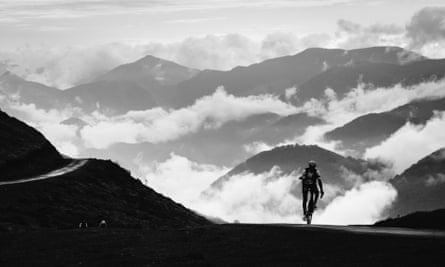
Essentials
Oliver Duggan cycled the Cent Cols Challenge with Rapha Travel - 13 days for £3,500, cycling through the mountains of southern France and Spain. The trip includes food and accommodation, physio, massages, training and mentoring, as well as a team of support vehicles. Flights are not included. For more information, visit Cent Cols Challenge or go to rapha.cc




Comments (…)
Sign in or create your Guardian account to join the discussion